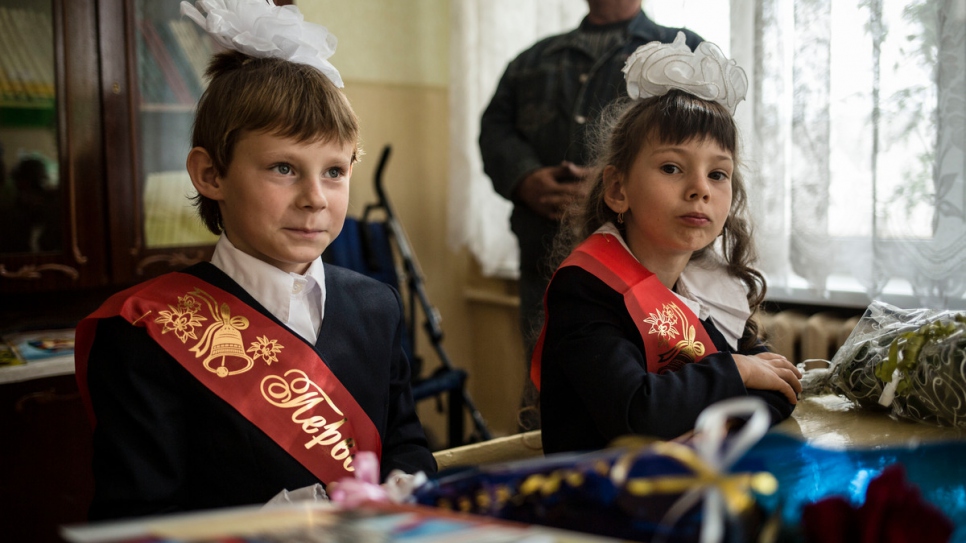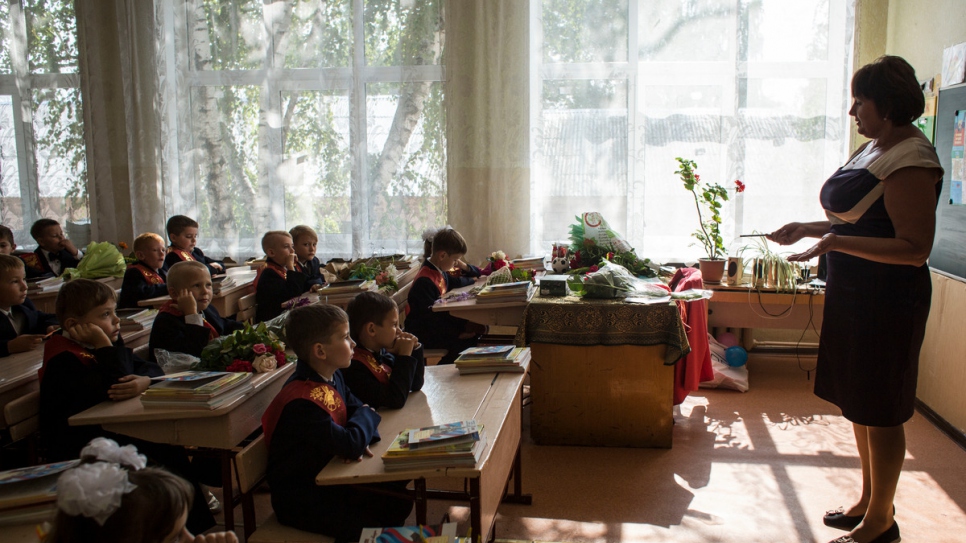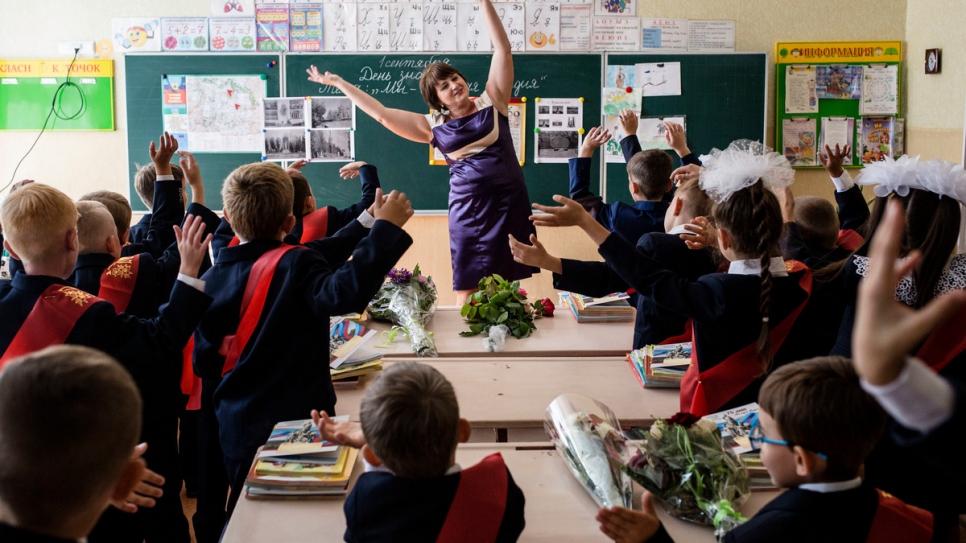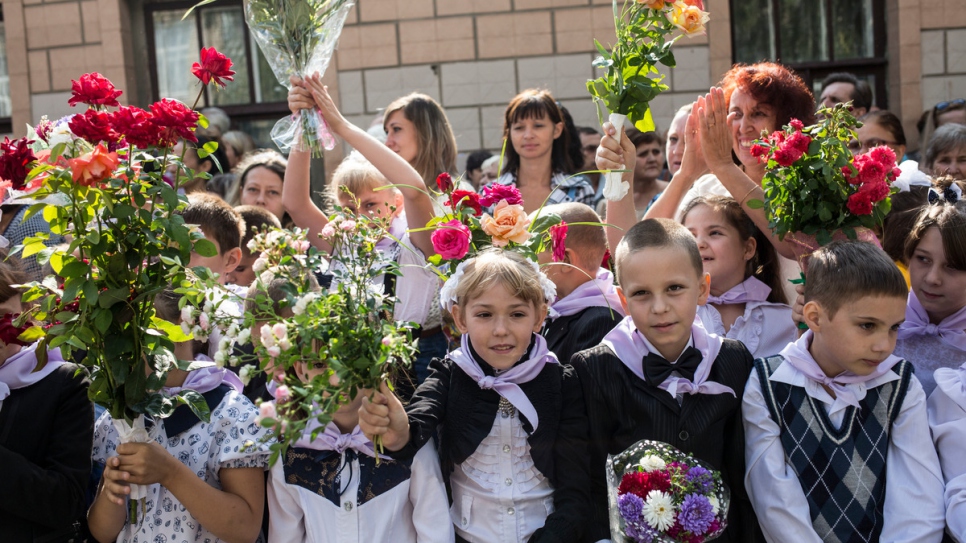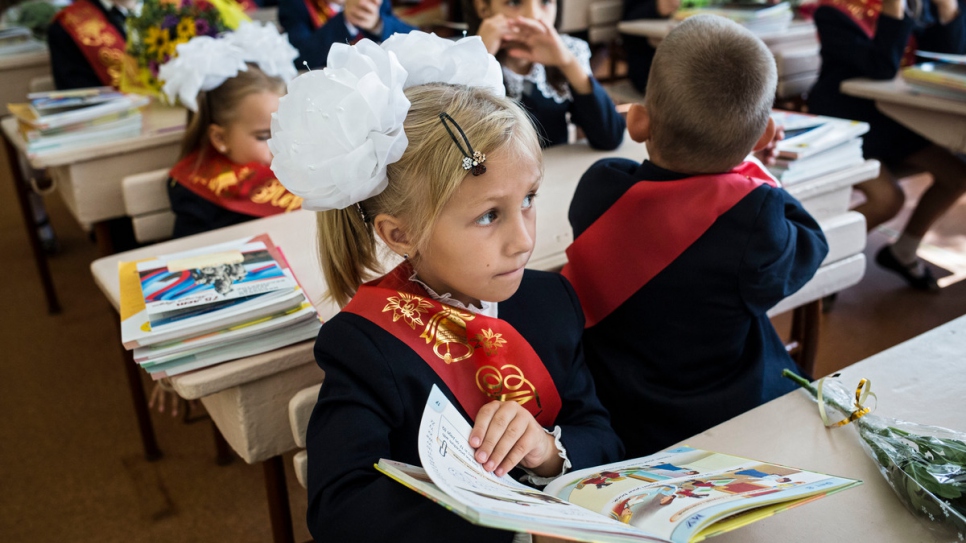Children of Luhansk start new school year hoping for peace
In Ukraine, where the ongoing conflict has damaged at least 700 schools, one class has started the new school year dreaming of peace.
Lera, 7, during her first lesson at a reconstructed school in Luhansk.
© UNHCR/Anastasia Vlasova
Seven-year-old Lera Holovko was all smiles as she entered school on September 1, holding a bouquet of red roses and ready to start the first lesson of her life.
Lera smiled despite the fact that she had woken up early to take a crowded bus to get to a school in Velyka Verhunka, a suburb of Luhansk, because the school in her village of Krasny Yar had been destroyed by shelling back in 2014.
The conflict in Ukraine has cost more than 10,000 lives and damaged at least 700 schools, including 55 since the beginning of 2017. Frequent exchanges of fire in areas near the line of contact continue to damage civilian infrastructure, and safety and security remain major concerns for nearly 800,000 people living in the country’s eastern Donetsk and Luhansk regions.
"I see some questions in their eyes. I see they are worrying."
On her first day at the newly reconstructed school, Lera proudly wore a big white bow on her head – a common local tradition – and a blue UNICEF rucksack on her back with essential stationery, delivered by UNHCR.
Teacher Antonina Strelets gave the first graders sheets of paper with sketches of white doves drawn on them.
“Kids, what is the most important thing in life?” she asked her class, as they began to color the sketches. “Peace,” they replied in unison. Someone added: “And love.”
Strelets, 53, said it was hard for her to be at the grand opening of the school year because it brought back memories of summer 2014, when her mother had been killed by shells that landed on her house.
Now the teacher notices that schoolchildren often have sad eyes. “I see that they are anxious and tense,” she said. “I see some questions in their eyes. I see they are worrying – they get these worries from their parents.”
She has also seen the conflict make many families significantly poorer, with children often experiencing a shortage of food and basic items such as clothes, books and toys. Many also miss their parents who must travel to make their living.
Lera’s mother has been disabled since childhood and the family live very modestly, without a father. They survive thanks to her grandmother who has worked as a concierge in Moscow for the last 15 years and earns around USD$245 per month.
With little money to prepare Lera and her sister Dasha, 13, for school, the family were delighted when Oleksandr Bakshy, the UNHCR shelter associate in Luhansk, brought a box of personal hygiene products, donated by the International Organization for Migration (IOM), the day before the school started.
“I ran to the school and saw our caretaker crying at the entrance."
Bakshy also promised that his team would install a new door on their house after the previous one was destroyed by shelling.
Since opening its office in Luhansk in autumn 2015, the UN Refugee Agency, UNHCR, has become a major supplier of UN assistance in this area. Its staff have delivered shelter repair materials to more than 1,500 families, rehabilitated 88 houses and, in 2017 alone, helped to repair 89 schools.
Lera’s school in Velyka Verhunka is one of them. Back in August 2014, a mortar shell fell in the playground, smashing windows and starting a fire.
“I ran to the school and saw our caretaker crying at the entrance, saying: ‘Our school is burning’,” the school principal Olga Sergeyeva said. She said 13 civilians had been killed in the town, but fortunately all of the children survived.
"It’s always loud in our school so we don’t hear the sounds of shelling."
Now the hole from the shell is covered with grass, but the school walls and iron gymnastic bars are still pierced by shrapnel. A colorful bear, bunny and cat made from old car tires brighten up the playground and distract children from the conflict. It is never far away – the children know that a forest plantation behind their playground is a mined area and are told never to approach the Siversky Donets river, which is now a frontline. The presence of unexploded ordinance around civilian areas threatens local populations and affects livelihoods.
Principal Sergeyeva, 57, who has worked at the school since the early 1980s, said that children are often afraid of thunder and do not like fireworks. But the teachers try to involve them in various activities to help them forget about the ongoing conflict.
“It’s good that it’s always loud in our school so we don’t hear the sounds of shelling here,” Sergeyeva said.
With the conflict in Ukraine now in its fourth year, UNHCR continues to call on all parties involved to ensure protection of civilians and civilian areas from the consequences of fighting and shelling.

